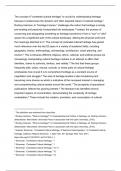The concept of "contested cultural heritage" is crucial for understanding heritage
because it underscores the dynamic and often disputed nature of cultural heritage.1
Rodney Harrison, in "Heritage Futures," challenges the notion that heritage is simply
pre-existing and passively incorporated into landscapes.2 Instead, the process of
conserving and designating something as heritage transforms it from a "ruin" or "wild"
space into a significant part of the cultural landscape, altering the physical world and
the meanings attached to it.3 The concept of contested cultural heritage has gained
much relevance over the last 25 years in a variety of academic fields, including
geography, history, anthropology, archaeology, architecture, urban planning, and
tourism.4 This is because different religious, ethnic, national, and political groups are
increasingly manipulating cultural heritage markers in an attempt to affirm their
identities, claims to authority, territory, and validity.5 The fact that these groups
frequently take, utilize, misuse, exclude, or erase parts of cultural heritage
emphasizes how crucial it is to comprehend heritage as a constant source of
negotiation and struggle.6 The area of heritage studies is also broadening and
becoming more diverse as which is indicative of the increased interest in managing
and comprehending cultural assets around the world.7 The prosperity of specialised
publications reflects this growing interest.8 The literature has identified several
important regions of concentration, demonstrating the complexity of heritage
contestation.9 These include the creation, promotion, and consumption of cultural
1 This definition was retrieved from class files.
2 Rodney Harrison, "What Is Heritage?" in Understanding the Politics of Heritage, ed. Rodney Harrison
(Manchester: Manchester University Press in association with the Open University, 2010).
3 Rodney Harrison, "What Is Heritage?" in Understanding the Politics of Heritage, ed. Rodney Harrison
(Manchester: Manchester University Press in association with the Open University, 2010).
4 Helaine, Silverman, “Contested Cultural Heritage: A Selective Historiography,” In Contested Cultural
Heritage, edited by Helaine Silverman, 1, New York, NY: Springer New York, 2011,
https://doi.org/10.1007/978-1-4419-7305-4_1.
5 Silverman, “Contested Cultural Heritage,” 1.
6 Silverman, “Contested Cultural Heritage,” 1.
7 Silverman, “Contested Cultural Heritage,” 10-11.
8 Silverman, “Contested Cultural Heritage,” 10.
9 Silverman, “Contested Cultural Heritage,” 10.
, heritage.10 It also explores the problems associated with for example the illegal
antiquity trade and empowering marginalized communities.11In addition, it discusses
the meaning of "value" in cultural heritage, the use of cultural heritage at the local
and national levels in an increasingly globalized world, the relationship between
politics and cultural heritage, and the importance of intangible cultural heritage.12 It is
anticipated that the relationship between heritage, human and cultural rights would
only grow even more in significance over the years.13 Understanding the ongoing
process of constructing identity and its situational and oppositional deployment is
another aspect of paying attention to contested cultural heritage.14 According to
Bruner (1983), society and identity are always being created and altered rather than
being permanent.15 This viewpoint, which was ground-breaking in the field of cultural
anthropology, offers a framework for comprehending the tactical applications of
legacy in making and rebutting claims.16
Contested legacy is thought to comprise both tangible and intangible components of
cultural identity that are inextricably linked to disputes stemming from divergent
interpretations or dialogues.17 It draws upon cultural customs, historical occurrences,
and symbolic meanings that hold significance for various populations, thereby
eliciting conflicting reactions.18 This is the arena where political, ethnic, and religious
groups compete to be the best when it comes to collective memory.19 The challenges
of recovering an excluded past illustrate the complex nature of contested cultural
heritage and how it can undermine the process if forging a national identity.20
Through their concept of "dissonant heritage," Tunbridge and Ashworth explore how
10 Silverman, “Contested Cultural Heritage,” 10.
11 Silverman, “Contested Cultural Heritage,” 10-11.
12 Silverman, “Contested Cultural Heritage,” 10-11.
13 Silverman, “Contested Cultural Heritage,” 10-11.
14 Silverman, “Contested Cultural Heritage,” 1.
15 Silverman, “Contested Cultural Heritage,” 1.
16 Silverman, “Contested Cultural Heritage,” 1.
17 Silverman, “Contested Cultural Heritage,” 10-11.
18 Silverman, “Contested Cultural Heritage,” 10-11.
19 Silverman, “Contested Cultural Heritage,” 10-11.
20 Silverman, “Contested Cultural Heritage,” 7.





